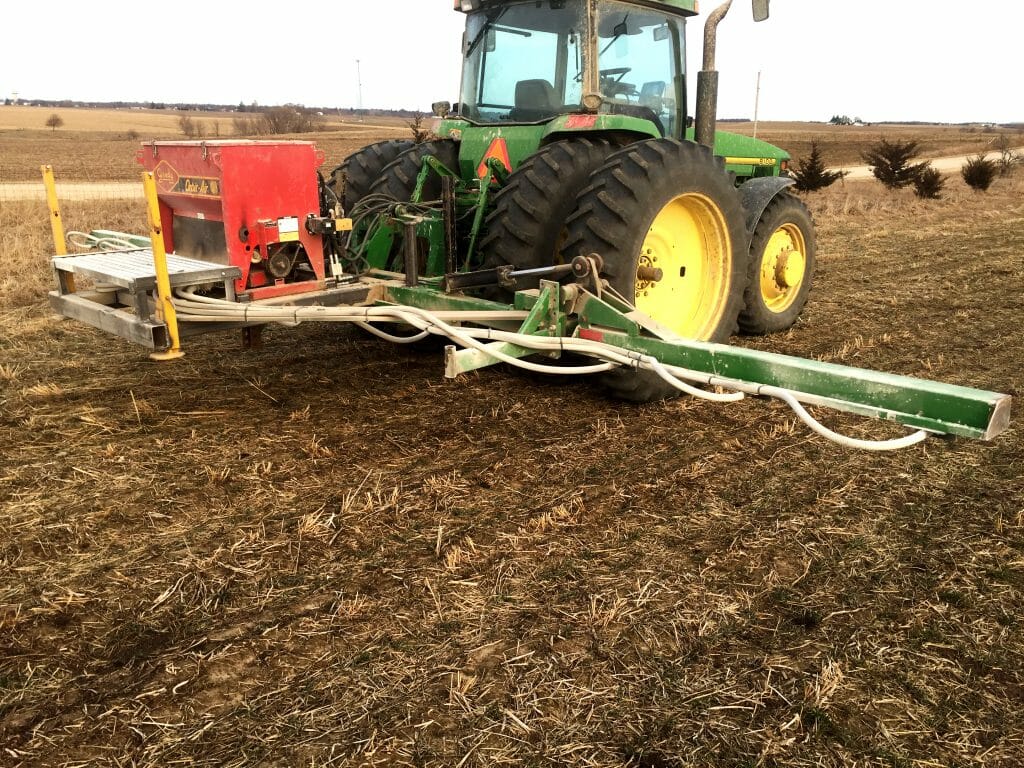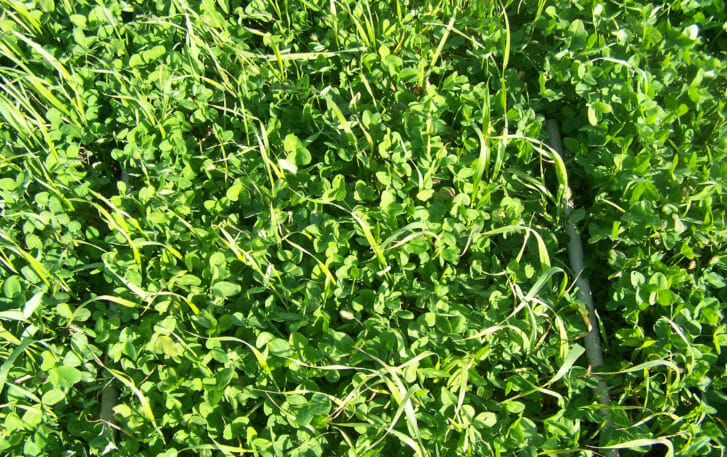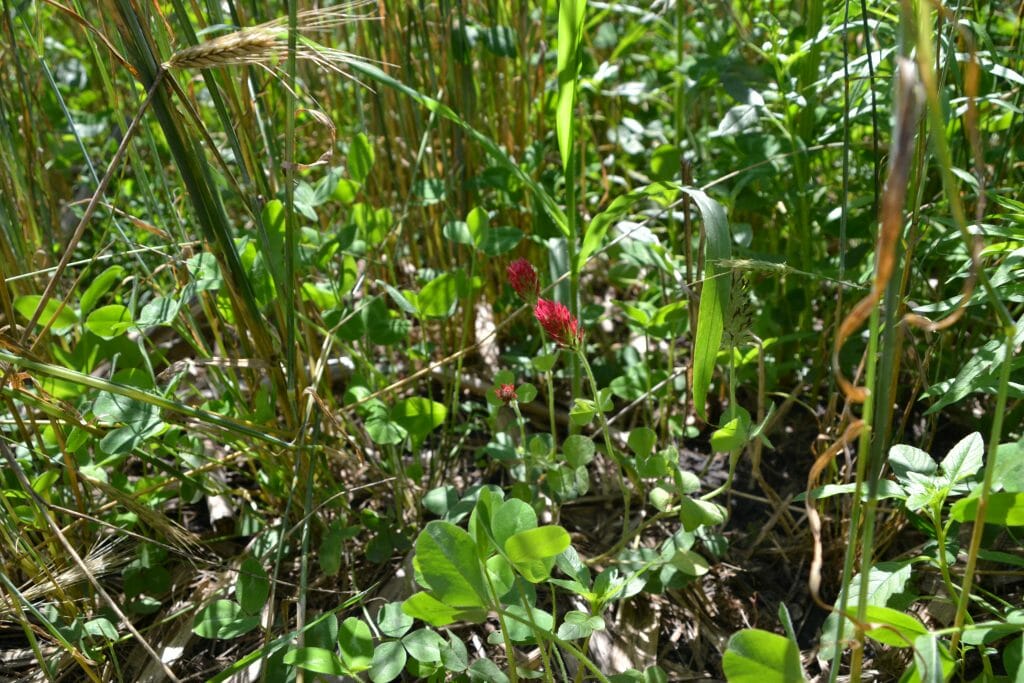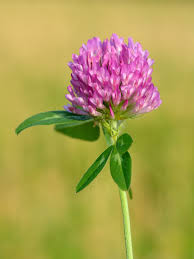Clover Cover Crop Management
Imagine it’s August 31, luckily it’s not too hot, so you’re out walking in the evening. You turn the corner around a tall field of corn and see a beautiful green blanket dotted with purple flowers in the next field. It smells sweet and the hum of butterflies and bees fills the air as they flit from flower to flower filling their bellies. Out of sight below the soil the bacteria are also hard at work; they’ve formed nodules that are actively fixing atmospheric nitrogen in the soil.
This is clover. A crop with so many benefits, but relatively little opportunity in the predominant corn-soybean rotation due to its susceptibility to cold winters and the heat unit requirement for the clover to begin fixing nitrogen and providing pollinator habitat. Adding a small grain into crop rotations, like wheat, oats, barley or rye, provides the perfect opportunity to re-introduce clover after July harvest of these crops.
On our January shared learning call Kevin Shelley, Farm Nutrient and Cover Crop Specialist with University of Wisconsin Extension, shared his experience working with corn-soy-wheat/red clover rotations at research stations and on his own farm. He shared his experience and lessons learned with clover establishment, management and termination.
Clover Establishment
Kevin’s preferred system for seeding clover is to frost-seed it into an established winter wheat crop. “We typically go out in March after we’ve lost our snow and we have conditions where we have freezing temperatures at night and thawing during the day. Typically, the seed will fall into the cracks that are formed by the freezing overnight and thawing during the day,” Kevin says. “The wheat will just be starting to grow, coming out of dormancy or still dormant.”
Kevin seeds clover at 8 to 12 pounds per acre which costs him $20 to $30 per acre in pre-inoculated seed. And, he cautions, be sure to plant an ideal population of wheat so that it’s set up to out-compete the clover. In southern WI where Kevin works and farms he recommends a seeding rate of 1.6 to 1.8 million seeds/acre if you’re planting wheat close to October 10, at the end of the optimum window for winter wheat establishment. “Keep that wheat competitive!” Kevin says, “Make sure that you have an adequate seeding rate and fertility.”

Doug Alert built this dedicated toolbar for frost seeding red clover. It’s a Gandy Orbit-Air seed hopper mounted on a used sprayer boom with a hydraulic metering system.
However, he cautions to pay attention to new weather patterns and to change your plan based on what you see on your own farm. “In recent years, we’ve had more overly-competitive clover than is desirable,” Kevin says. “It’s been a little bit more aggressive and competing with the wheat to the point of causing a yield reduction, possibly due to more moisture at wheat maturity or the cooler springs we’ve had that are holding wheat back.”
One idea he’s tinkering with is to try a sequential seeding of annual clover like crimson or berseem planted after wheat harvest. Previously, lack of moisture and hot conditions in July-August made for poor clover establishment when seeded after wheat harvest. “But,” Kevin says, “now we’re getting more rain at that time of the year, a sequential seeding of berseem or crimson clover might thrive.”
Another factor to consider is how clover fits with your herbicide plan. “If we’re frost-seeding in March, that’s only nine to ten months after most post-emergent herbicides applied to soybeans,” Kevin says. “We have to be cognizant of what herbicide we had used, so we don’t plant clover in a situation where it’s not going to grow. And if it’s going to be harvested as hay or forage then you may be off-label.”
Clover Management
By frost seeding clover in March, one benefit is getting a jump on biomass production. It hangs low under the wheat canopy until harvest, but then it’s poised to take off once it gets more sun. This biomass production provides the opportunity to take a harvest of forage off the field. Kevin estimates that you could expect 1.5 to 2 tons of dry matter harvesting clover as hay in mid-September. He has been lucky enough to bale dry hay at that time of the year before, but baleage is also an option if the weather is too wet.
If you are intending to maximize clover production on sandier soils, make sure that sulphur levels are sufficient. Also be sure to account for the fact that if you’re harvesting forage the fertilizer replacement value for 1.5 to 2 ton dry matter is 30 to 45 pounds of phosphate, 90 to 100 pounds of potash, and sulphur, totaling about $40 to $50 per acre in fertility costs.

Red clover as a green manure cover crop, underseeded with oats, at Ash Grove Farm in north-central Iowa in October of 2016.
If he’s not going to harvest forage, Kevin usually considers clipping the clover. “Clipping a clover at its flowering period in mid-August to mid-September will encourage new growth with additional N fixation, clips weeds before they set seed and can help control diseases like powdery mildew,” Kevin says. This isn’t necessary in every year for weed control or powdery mildew, so scouting is important in determining whether you’re going to do a clipping.
Clover Termination
When it comes to termination, there are two main options – tillage or herbicide – and two timing options – fall or spring. Kevin favors fall termination because in the past the weather has been more reliable to get into the field. “I have terminated the clover in the spring,” Kevin says, “but I don’t think there is a big advantage unless there’s some slope or something that requires the soil to be more protected.”
On his own farm, Kevin practices no-till so he relies on herbicide termination. In October when daytime highs are at or above 50 degrees Fahrenheit for two or more days, and the clover is actively growing, he sprays growth regulator herbicides like 2,4-D or dicamba at 1 pound of active ingredient (2 pints of product total). He says one pint of each mixed together works well. You can add glyphosate, but it’s not necessary. In the spring he recommends the same herbicide plan, but more preference for adding glyphosate. In the spring, this should be applied once temperatures are consistently above 60 degrees Fahrenheit during the day and above freezing at night.
Tillage termination will only be effective if the crowns and roots are exposed to the air so they dry out. Unfortunately, it is difficult to achieve this effect without aggressive tillage, which leaves soil exposed over the winter if it’s done in the fall. However, if you wait until spring, high soil moisture can make it hard to find a good window to conduct tillage. In order to have a shallow tillage pass be effective you’d have to separate the crowns from the growing point, which in theory could be done with two passes of shallow tillage, but, Kevin warns, this is not always reliable.
Another issue to consider with spring tillage termination of clover is the increased likelihood for seed corn maggot. “That green, rapidly-decomposing organic material attracts seed corn maggots,” Kevin says. “Most seed corn treatments will be effective against it, but if you’re organic or you don’t want to use seed treatment, you will want to look for those flies, and if they’re present then wait two weeks after clover termination to plant corn.”
This is not generally as large of a concern with spring herbicide termination because the clover dries down quickly after herbicide application and is then not an attractive host for the seed corn flies. It doesn’t hurt to scout though, even with an herbicide termination. All in all, Kevin notes that spring termination is riskier, and not necessarily that advantageous for maximizing clover benefits like nitrogen production.
Nitrogen Credit to the Next Crop and Yield Increases
After terminating the clover, most farmers will plant corn to make use of the nitrogen the clover crop fixed biologically. But, it can be hard to predict how much and when that nitrogen will be available. “Recent trials show pretty varied results, you can measure the amount of N accumulated in aboveground biomass and in the roots,” Kevin explains, “But, it varies quite a bit in the amount that will be mineralized and available to the following crop.”
Most universities estimate a 40 to 80 pound N credit from clover – which Kevin notes as perhaps conservative – depending on stand density and whether the clover was established in the spring or summer. “That’s a $24 to $30 per acre value of that 60 to 80 pound N reduction on your fertilizer bill, which is roughly equivalent to the cost of the clover” Kevin says. If you’re unsure how much nitrogen the clover has provided, you can always take a pre side-dress nitrate test and then top up the nitrogen needed for the corn crop with a side-dress or y-drop application of fertilizer.

Clover growing under a small grain canopy at Brent Larson’s farm. This photo was taken on June 29, 2018.
In addition to the N credit, Kevin cited a 12% corn yield increase following a wheat/clover year. A meta-analysis conducted by Jim Stute of Michael Fields Agricultural Institute attributed the 12% corn yield increase to a “rotational effect.” Kevin says, “With the additional yield benefit plus the N credit, we’ll more than cover planting costs and other risks associated with cover crop management.”
For additional questions about Kevin Shelley’s research and experience with clover you can contact him directly via email. PFI holds shared learning calls on small grains, cover crops and other topics related to extended crop rotation on the first Friday of each month. Sign up for the small-grains newsletter to get upcoming call details straight to your inbox.


